

Click it again to go to the document or webpage.
#hyflex #blendflex. Meaningful Assessment – UCSB Keep Teaching. Youtube. By Students, For Students - Stories - News & Events - Santa Clara University. The student-run LEVL UP program uses student insights from remote learning so other Bronco undergrads get the most out of their online education this quarter.
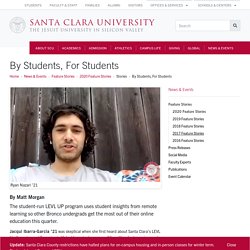
Jacqui Ibarra-Garcia ’21 was skeptical when she first heard about Santa Clara’s LEVL Up (Learning and Engaging in Virtual Learning) program. After sitting for hours in remote learning classes during the spring quarter, the last thing Ibarra-Garcia wanted to do was spend more time in front of a computer screen. But when she watched a sample of the student-produced videos herself, the marketing major realized this remote learning tutorial program was different. “The videos were personal,” Ibarra-Garcia says.
“That’s what stuck out the most to me. She was so impressed with the videos that she decided to join the LEVL Up team as a student promoter to help publicize the program, which has already reached thousands at SCU. It’s in the skill acquisition section where things got personal. Learning in blended hybrid hyflex courses student handbook spring2021. Fall 2020 HyFlex Workshops for Students - Seton Hall University. The Teaching, Learning and Technology Center has created a catalog of workshops to help students prepare for their Fall courses and utilize different technologies to enhance learning remotely and in the HyFlex model.

To register for a virtual workshop, visit the university event calendar. Hybrid Flexible Courses: A Teachers Guide to Hyflex. How to conquer teaching during a pandemic We have to recognize that educators have responded amazingly to the abrupt shift to online teaching.

Of course, it hasn’t been easy, but in general terms, it all worked out pretty well. I mean, we were agile. We adapted and effectuate with the resources we had at hand and tried to continue providing our very best to our students. Other organizations couldn’t adapt that well. HyFlex Course Design – Example 50-Min & 75-Min Class Sessions - Google Docs. COVID-19 Planning for Spring 2021: What We Learned About Hybrid Flexible Courses in Fall 2020 - PhilOnEdTech. Given that the coronavirus is resurging, mutating and more, we know that Phase 3 of higher education’s response to COVID-19 will continue into spring 2021 (see Phil Hill’s updated chart of all 4 phases below).

Last spring, I took a closer look at hybrid flexible course design as one option to maintain instructional continuity in fall 2020. Now that 2020 is over, it behooves us to explore fall 2020 implementations of hybrid flexible, or HyFlex, courses and to derive lessons that will help us better support students and faculty this spring. How Did Campuses Describe the HyFlex Experience? In Romeo and Juliet Shakespeare wrote, “A rose by any other name would smell as sweet.” HyFlex by any other name usually implies a different set of initial conditions. 3 HyFlex lessons from the pandemic and what's next. As the coronavirus pandemic forced college classes online, the higher ed community was buzzing about an instructional model called HyFlex.
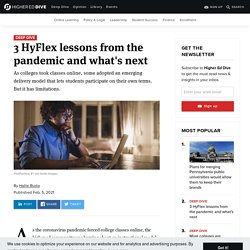
The concept wasn't new. In its truest form, HyFlex, sometimes called hybrid-flexible, calls for courses to be created in a way that gives students complete control over how and when to participate, either in-person or online. Hybrid, HyFlex, Online, and Everything in Between: Course Models at a Glance. As higher education’s instructors and administrators plan for fall 2020, there has been a lot of discussion about what different course models might look like given the interactions that might span places, spaces, and time zones.

Joshua Kim and Edward Maloney published a fantastic series on 15 possible scenarios for fall, while universities across the U.S. have been gradually rolling out announcements about whether or how they will bring undergraduate students back to in-person instruction in the fall. Where I currently work, at Stanford University, we recently learned that undergraduate students will be brought back to stay in residence halls in class-based cohorts. COVID-19 Planning for Fall 2020: A Closer Look at Hybrid-Flexible Course Design - PhilOnEdTech. Since I have only written guest blog posts, many of you won’t know of my plans to write a modern-day, Gulliver’s Travels-esque satire.

The hero or anti-hero – I haven’t yet decided which – travels time instead of oceans. Namely, he can jump to different possible futures and see the repercussions of present day decisions. How many of us would like that ability right now, as we make decisions about fall 2020? I bring this up because I recently included a brief paragraph about how we should “consider ‘hybrid flexible’ course design to support ‘remote flexible’ courses” in the fall. Faculty Playbook Final. Digital Toolbox: Developing a Hyflex Course. By Jeff Kuhn, Audra Anjum, and Patrick Mose from the Office of Instructional Innovation At a Glance Hyflex helps you ensure that all students learn, regardless of whether: They cannot attend a face-to-face session (e.g. due to being immunocompromised) They are unable to attend a synchronous online class session (e.g. due to illness, low internet bandwidth, etc.)
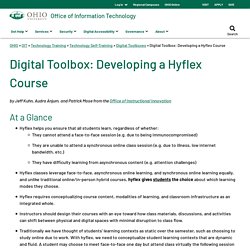
They have difficulty learning from asynchronous content (e.g. attention challenges) Hyflex classes leverage face-to-face, asynchronous online learning, and synchronous online learning equally, and unlike traditional online/in-person hybrid courses, hyflex gives students the choice about which learning modes they choose. Hyflex requires conceptualizing course content, modalities of learning, and classroom infrastructure as an integrated whole. Operating in the New Normal: A Toolkit in Response to COVID-19. Active Learning in Hybrid and Physically Distanced Classrooms. Posted by Derek Bruff on Thursday, June 11, 2020 in Resource. by Derek Bruff, Director If you’ve read Norman Clark’s hypothetical day in the life of a physically distanced classroom, then you’ve probably started to worry about how faculty and other instructors might facilitate discussion, group work, and other forms of active learning this fall.
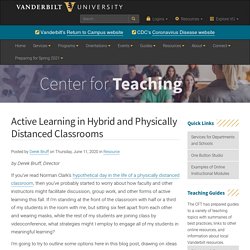
If I’m standing at the front of the classroom with half or a third of my students in the room with me, but sitting six feet apart from each other and wearing masks, while the rest of my students are joining class by videoconference, what strategies might I employ to engage all of my students in meaningful learning? I’m going to try to outline some options here in this blog post, drawing on ideas and resources from across the higher education community, but I would enthusiastically welcome additional approaches in the comments below or via Hypothesis annotations. I’m also assuming a few practical things: Now, let’s talk about strategies… Teaching: How To Engage Students in a Hybrid Classroom.
Many instructors are dubious, to say the least, about how well this will work.
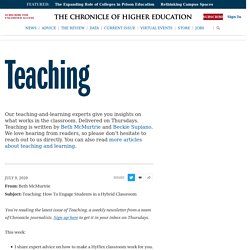
They want to know how they can engage students who are spread all over the place. They worry about being forced to teach in a lecture format, in which active learning seems impossible. They don’t understand how they can keep track of questions and comments from all of their students without a teaching assistant to help. Youtube. Engaging Zoom Classes. Assign a group of students to solve a problem, debate a topic, or engage in a discussion while the rest of the class watches and shares their reactions via Zoom chat. Estimated class time: 5-15 minutes Using “comment-only” permissions, share cloud documents with student groups that have statements, proofs, or other material that contain errors and ask the groups to suggest corrections to the errors. Have students think about a shared prompt or discussion topic, then split them up into pairs or small group breakout rooms to discuss their own views on the topic. Afterwards, have each group share their thoughts back to the wider class once the Zoom breakout rooms have ended.
Teaching: Your Questions About Hybrid Teaching Answered. This week, Jenae Cohn, an academic-technology specialist for the program in writing and rhetoric at Stanford University, examines the challenges of technology and active learning. Making effective use of technology for your in-person students: “Pretty much all of the Hybrid (or HyFlex, or whatever you call it!) Discussion seems to imply that in-person students will need to bring technology to log in to Zoom to interact with other students,” writes Janet Samuels, a clinical professor in the School of Accountancy at Arizona State University.
“However, our undergrads are not required to have laptops or tablets, and many of my students come from a socioeconomic background where acquiring a laptop would be a burden on them. “Do you have suggestions for engaging students in a hybrid classroom if the in-person students don’t log in to Zoom or have access to technology? Jenae Cohn’s response: I would definitely encourage this instructor to leverage mobile learning more with her students. Teaching in the Concurrent Classroom: Four Strategies to Make it Work by Dr. Catlin R. Tucker. Teaching in the Concurrent Classroom: Four Strategies to Make it Work – Dr. Catlin Tucker. On Thursday night, I presented a 30-minute webinar with AJ Juliani for educators focused on the concurrent classroom.
If the phrase “concurrent classroom” is unfamiliar, it’s when teachers have a group of students in the physical classroom and a group joining simultaneously online via video conferencing. An increasing number of educators are teaching in concurrent classrooms as schools attempt to accommodate families who want their kids back in classrooms and others who prefer to keep their kids in a virtual learning mode.
Tip: "ZoomFlex" & Flexible Design Strategies - Tips for Teaching Professors. As I think about planning for fall - where I’ll be teaching some “remote synchronous” (live attendance requirements) and some “online” (fully asynchronous) sections, I have found inspiration in this video, below, created by Mike Caulfield explaining “ZoomFlex” - how to accommodate some synchronous/some asynchronous students this fall. He encourages us not to ask: How do we create a face-to-face class while including an online audience? But rather to ask: How can we create an online experience that we can include face-to-face students in?
I think of flexible design as an opportunity to meet students where they are. Tip: Zoom & live class meeting options - Tips for Teaching Professors. We - mostly - have survived the spring pivot to remote learning. If teaching over the summer, you’re probably trying to figure out exactly what that will look like. In the urgent pivot of the spring, we each did our best to meet our students where they were, with not a lot of time to reflect. Now is the time to take a moment to explore different interpretations of what “remote delivery” looks like, and make the most informed decisions possible. Why is everyone using Zoom? Synchronous online classes provide definite benefits, the greatest of which is student-instructor and student-student relationships. I would ask, however, that you think about the many Zoom-facilitated meetings and webinars you’ve attended over the past two months.
What is wrong with Zoom (and multitasking while Zooming)? Misconceptions About Hyflex, with David Rhoads. How to Manage a Hybrid Classroom. Hyflex Learning, with David Rhoads. Preparing to Teach a Hybrid/HyFlex Course - Google Docs. HyFlex Classroom Resources and Information - For Instructors - Higher Ed and Technology: Academics at Chapman. HyFlex Classroom Management Checklist - Higher Ed and Technology: Academics at Chapman. Educational Technology Services - Home. Student Technology Experts. Starting the second week of February, 2021, IS&T will be rolling out a new service to provide virtual support to help Faculty with class Zoom meetings. This new service is being provided by a team of Student Technology Experts (STE) who are formally trained in Zoom. They will act as the co-host of Zoom meetings to help manage the waiting room, breakout rooms, screen sharing, and monitoring in-meeting chat.
Reservations can be made starting Friday, February 5th. The Student Technology Experts are not authorized to support other areas such as Canvas and Grades. JanCon 2021: Lightning Talks - Teaching in a HyFlex Classroom. Planning for the Unknowns 1-22-21 - Google Slides. 1-22-2021 Planning for the Uknowns (and Knowns) of Future Semesters.
Chapman Classrooms. Chapman University. Exploring HyFlex Problems & Solutions - Recording and Slides Available - Higher Ed and Technology: Academics at Chapman. Dear Chapman Faculty and Staff, Here are some Zoom resources that we encourage you to take advantage of. Going through these resources will help you navigate through your Zoom meetings and manage your Zoom meetings better. Meeting Controls Breakout Rooms Sharing Your Screen Manage Participants Also, Zoom has created a YouTube channel with lots of Dear Chapman Faculty and Staff, Here are some Zoom resources that we encourage you to take advantage of. Going through these resources will help you navigate through your Zoom meetings and manage your Zoom meetings better.
Meeting Controls Breakout Rooms Sharing Your Screen Manage Participants Also, Zoom has created a YouTube channel with lots of Dear Chapman Faculty and Staff, Here are some Zoom resources that we encourage you to take advantage of. HyFlex Classroom Types and Resources - For Instructors and Staff - Higher Ed and Technology: Academics at Chapman. Exploring HyFlex Problems & Solutions. HyFlex Basics and Class Design Tools - July 7, 2020. Prime HyFlex Classroom Training. Chapman University Service Desk. Fall Scenario #13: A HyFlex Model. ELI7173. ID11 1931 Bower Report handbook 2014. What You Should Know About HyFlex Blended Learning. Editor’s Note: We’ve been reading recently about different forms of blended learning, and stumbled upon this idea of “HyFlex” blended learning, where students combine some of the freedom of MOOCs with the in-person resources of a traditional college campus. The result is “HyFlex” blended learning, and while it may not be the “answer,” it certainly represents an interesting possibility.
If nothing else, it reflects students’ desire for choice in the learning process. What is a HyFlex course? Student Choice, Instructor Flexibility: Moving Beyond the Blended Instructional Model. HyFlex Course Development Guide. Hybrid model: The new normal for education will be a mix of online and in-person classes. One option for delivering instruction if campuses open this fall: HyFlex. Library.educause. Er.educause. Hybrid-Flexible Course Design. Blended modalities resources. Blendflex lets students toggle between online or face-to-face courses.
Our HyFlex Experiment: What’s Worked and What Hasn’t. Youtube. Northern Arizona University. Office of the University Provost. ASU Sync Classroom Management Webinar - July 2020. Northeastern University. Shenandoah University. Flexible Hybrid Model for Fall 2020 Teaching and Learning. Teaching Hybrid Courses. UCF to Add New BlendFlex Class Format. Augustana to Offer Majority of Fall 2020 Classes In-Person or in Hybrid/Flex Format. Teaching & Support Resources.